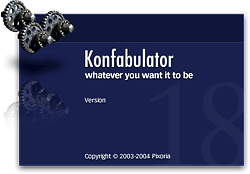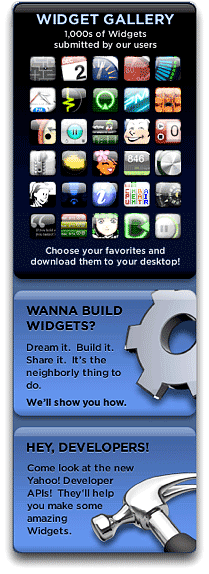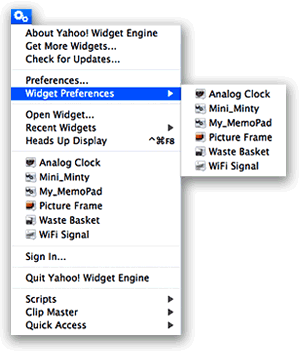Articles In Category
Apple: Optimizing Web Applications and Content for iPhone
Automator Development Tip
Firebug Lite: Simulate Firebug Calls in Opera and Safari
Weather Channel Widget: It’s A Must To Avoid
Widgets 1.0: W3C Drafts A Widget Spec
Fidelity Market Monitor Widget: The Best Stock Market Widget Bar None
Amnesty Singles: Convert Dashboard Widgets for Desktop Use
Desktop Picture Imperium: A Widget for Controlling Your Desktop Pics
Does Anybody Really Know What Their IP Address Is?
In our modern, interconnected, always-on age, knowing one’s IP address comes in real handy at times. Knowing your IP address isn’t quite as important as knowing what time it is, but it helps to have an IP clock handy when you need it.
I’ve dabbled with quite a few solutions to this problem over the last few years, and there are a large number of decent IP clocks available… most of them for free. In my IP ramblings, I’ve ruled out solutions that work only in the Dock and ones that put an IP address right in your menubar. I don’t use the Dock that much anymore (between Quicksilver, ClawMenu, Dashboard, and menubar widgets, I don’t need it), except in its application switcher form. And IP addresses printed directly in the menubar take up too much valuable space and are invariably ugly.
Virtual Dashboard: Virtual Desktops for Dashboard
Amnesty Generator: Convert Google Gadgets to Dashboard Widgets
Widgetbox Is An Amazing New Resource for Web 2.0 Site Developers
Apple Releases New “Resizer” Sample Widget
AppButton: A Powerful Launcher in Widget Form
CSS Tweak: Optimize Your CSS Online or With Dashboard Widget!
Yahoo! Widget Engine: Konfabulator’s Legacy A Worthy Sidekick for Dashboard
 I admit I was skeptical when Yahoo took over Konfabulator last year. Apple had released Dashboard for Mac OS X 10.4 (”Tiger”), which had some clear advantages over the old Konfabulator widget model. The first time or two I tried the Yahoo widgets, I was singularly unimpressed not only with the performance of the widgets but also
I admit I was skeptical when Yahoo took over Konfabulator last year. Apple had released Dashboard for Mac OS X 10.4 (”Tiger”), which had some clear advantages over the old Konfabulator widget model. The first time or two I tried the Yahoo widgets, I was singularly unimpressed not only with the performance of the widgets but also  with their quality. They reminded me of why I had never been impressed with Konfabulator, although I’m sure Konfabulator’s wanting money for their product had something to do with that, too.
with their quality. They reminded me of why I had never been impressed with Konfabulator, although I’m sure Konfabulator’s wanting money for their product had something to do with that, too.
Also there was Yahoo! itself… a company that until the last 12 months or so had been growing more conservative, more commercial, more corporate, and less fun than the Yahoo I started loving 10 years ago. Not only that, but Yahoo appeared to be less and less friendly toward the world’s Mac-minded minority. I had grown so disenchanted with Yahoo mail that I finally gave up last summer and packed my bags for the terrific IMAP mail service called Fastmail.  So it was a bit of a surprise when Yahoo wandered into territory that originally had been 100% populated by Mac-type aliens. Clearly, the visionaries had regained some influence at the company, as other recent smart moves testify (see all the cutting edge Yahoo goodies at the Yahoo Developer Network).
So it was a bit of a surprise when Yahoo wandered into territory that originally had been 100% populated by Mac-type aliens. Clearly, the visionaries had regained some influence at the company, as other recent smart moves testify (see all the cutting edge Yahoo goodies at the Yahoo Developer Network).
So, when I downloaded the Yahoo Widget Engine (YWE) 3.0 in December, I was pleasantly surprised to notice that things had changed quite a bit. Setting it aside until last month, YWE 3.1, the latest release as of this writing, confirmed my first impressions. YWE widgets are now very well behaved, for the most part, and take no more system resources than Dashboard widgets do. Plus there are actually some widgets that don’t have good Dashboard counterparts.

But finding more great widgets isn’t the only thing that’s made YWE a standard part of my desktop. What I really admire is the YWE implementation of widgets, which has firmed up my longstanding view that Apple needs to modify the Dashboard concept to make it more flexible, if they want Mac users to truly embrace widget-dom. The particular traits I admire are nothing new… they were standard in Konfabulator, and there’s one application for Mac OS X called Amnesty that will emulate the concept. I have stubbornly refused to pay the $20 that Mesa Dynamics wants for Amnesty, especially now that I use YWE, which does most of Amnesty’s tricks for free. So what exactly are those tricks?
- Run widgets like normal applications outside of Dashboard
- Easily change a widget’s “window level”–meaning, where it resides starting from the desktop itself up to a window that floats persistently above all regular windows, with several layers in between.
- Ability to lock a widget in place
- Ability to set transparency for a widget.
- Ability to access widgets–and their preferences–from a handy menubar item.
- Ability to stop and start the widget layer as the need arises.
BitMemo: Elaborate, Full-Featured Notes Widget
Cool, Colorful DHTML Navigation Menu
xCuts Dashboard Widget: Tripping the Light Script.aculo.us
 I’ve been writing for some time now about the kinship between Apple’s Dashboard Widgets and web pages. I’ve recently written a time or two about Ajax and the various wonderful dynamic HTML (DHTML) JavaScript libraries that are now available to web developers. And when I first starting compiling the lists of available Ajax/DHTML JavaScript libraries, I was planning to grade Apple’s Widgets library along with all the rest. In explaining why I didn’t, here’s what I wrote last month about Widgets and DHTML pages:
I’ve been writing for some time now about the kinship between Apple’s Dashboard Widgets and web pages. I’ve recently written a time or two about Ajax and the various wonderful dynamic HTML (DHTML) JavaScript libraries that are now available to web developers. And when I first starting compiling the lists of available Ajax/DHTML JavaScript libraries, I was planning to grade Apple’s Widgets library along with all the rest. In explaining why I didn’t, here’s what I wrote last month about Widgets and DHTML pages:
It’s interesting that 2 months after an Adaptive Path essay coined the term “Ajax,” Apple released Mac OS X 10.4 “Tiger”, with its amazing and powerful dashboard widgets system. Within a couple of months, there were over 1,000 widgets available on the web, and these little babies were capable of completely replacing (almost all for free!) a number of system utilities, menubar items, and whole applications on the Mac. I’m tempted to think that awareness of Apple’s widgets helped promote awareness of, and interest in, what could be accomplished with rich Ajax/DHTML toolkits. After all, widgets are simply little Ajax/DHTML programs running in a special layer of Mac OS X called the Dashboard… They use exactly the same technologies as all of the Ajax/DHTML libraries, and in fact you can run them inside of Safari outside of the Dashboard.*
And so, it was fitting that when I finally found time to work on a widget I’d been planning to build since last summer, I decided to use one of the leading Ajax/DHTML toolkits rather than Apple’s own, for most of the widget’s functionality. Having done most of my recent DHTML web work with Prototype and its light-hearted, freewheeling sidekick, Script.aculo.us, I naturally turned to those libraries to help me out.
PHP Function Reference Widget
Developing Dashboard Widgets
ShortStat Widget: For Your Stat-Checkin’ Addiction)
JSEclipse: Edit JavaScript with ease.
Desksaver Plus: Dashboard Widget Runs Screensavers on the Desktop
Noodleboard: Web-Based Collaboration with a Dashboard Widget
WikityWidget: A Widget That’s A Wiki, or A Wiki That’s A Widget?
Anyone Can Develop A Dashboard Widget (And They Probably Will)
 Wow! This project really took me back a few years… and forward a few years as well.
Wow! This project really took me back a few years… and forward a few years as well.
Building this widget also took me back by confirming what I had read about Dashboard widgets–namely, they are really just little web pages that use transparency and run outside of a web browser. They can do more than web pages can do if you get fancy with them, and Apple has added some spectacular animations to Dashboard to make them look cooler than anything a browser can do, but… bottom line… if you know HTML, javascript, CSS, and graphics, you can build a Dashboard widget!
The project took me forward a few years as well, since I got a clear glimpse of what life beyond browser-based HTML will be like a few years from now. I was skeptical at first, but because of both the explosion of Dashboard widgets since May 1 and the amazing usefulness of many of them, I’m now convinced that this new way of getting web information is the future. It’s really the next step beyond Sherlock, and in some ways is just an extension of RSS and an easy way of leveraging web services on your desktop. If I needed any confirmation for my gut feeling on this, Yahoo provided it this week by gobbling up Konfabulator (before Microsoft could get to them, I’m sure)! (More on that later…)














